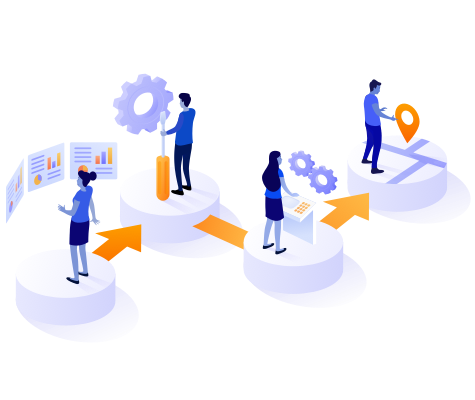How to get started with Lean Portfolio Management
Share on socials
How to get started with Lean Portfolio Management

Tina Behers
Published on 5 March 2024
6 min read


Tina Behers
Published on 5 March 2024
6 min read
Adaptability, agility, and speed are crucial in the constantly evolving business landscape. Because of their complex nature, enterprises must navigate the choppy waters of constant change more than most—but Lean Portfolio Management can create a clear path towards enterprise agility.
In this blog, we will explain what Lean Portfolio Management is, the fundamental principles within the Lean methodology, and how you can get started with implementing LPM within the Scaled Agile Framework® (SAFe®) and unlock the benefits of agility at the enterprise level. Let's begin!
This is the second blog in a series exploring portfolio management. Learn more about strategic portfolio vs project portfolio management in our blog: Bridging the gap.
What is Lean Portfolio Management?
Lean Portfolio Management (LPM) describes the process undertaken by a portfolio or product manager to apply Lean principles (or steps) to execute a portfolio strategy. LPM focuses on aligning business strategy with agile development to drive value, improve agility, and minimise waste.
Let’s take a look at the five basic principles of Lean management:
- Identify the value of your product or service.
- Map the value stream.
- Create flow and promote efficiency by eliminating waste from your workflow.
- Respond to customer pull by focusing on products in demand.
- Embrace continuous improvements to your workflow.
"There is nothing so useless as doing efficiently that which should not be done at all.
Peter Drucker
Six steps to get started with Lean Portfolio Management
Follow these six steps to put LPM into action for your next project.
- Assemble your A-team
The right people with the right skills and knowledge are essential for successful LPM. Your portfolio managers should excel at gathering data, monitoring project performance, and influencing those in charge of priority management. - Secure funding
As you might expect, there are costs involved with transforming business strategy into execution. Finding funding usually means working with existing resources and figuring out where a project fits into the budget—any gaps and you will have to restructure the project. Identify the projects that cost the most and are of highest priority to stakeholders and evaluate the budget to allocate funding. - Outline your game plan
The next step is to build your operating structure, which will establish your approach to the project. What area will you start working on first? Will everyone in the team work on different parts or together? Remember the five principles of Lean methodology, as outlined above, and identify inefficient practices in your original portfolio management method. - Establish a Lean workflow
The next step is to establish a lean workflow by removing inefficiencies and anything holding up your portfolio management process. Identify your past mistakes and then try a different approach. For example, instead of the whole team working on one role, task, or area, you could allocate different roles to team members to make the operation run faster. You can establish a pull system to notify you when each stage of the process is complete, or you might try using portfolio management software, Kanban tools, or Gantt charts to visualise the different stages of your portfolio management process. - Polish up your workflow
Implementing Lean initiatives is a big adjustment, so you'll likely need to add upgrades and make amendments. It's good practice to approach the process with a flexible mindset focused on continuous improvement. - Celebrate your success
The achievement of bringing your business strategy to life and implementing Lean principles is worth celebrating—even if things don't go to plan. Any mistakes you make can be lessons you use to optimise and refine the process for next time.
Copied!
Common challenges
Once adopted, LPM is a new way of managing a portfolio that can help you improve your agile workflow and drive the value of your delivery. Implementing LPM will take time, patience, and focus—primarily if your team uses a traditional portfolio management system.
The most common challenges that hinder organisations from fully embracing effective LPM fall into three main categories:
- Challenges with alignment: When different levels of your organisation are disjointed, it's more difficult to communicate strategy or move towards established goals.
- Challenges with predictability: When disjointed teams work with gaps in the data needed to guide them, releases become more complex, and KPIs can become neglected.
- Challenges with governance: Organisations face challenges with agility when metrics, reporting, and monitoring are poorly controlled.
An overarching management platform can help you address these challenges and is the best way to set your organisation up for success. A good platform can keep programs and release trains moving, provide your program managers with a top-down approach to monitoring and managing widespread development teams, and connect top-level strategy to day-to-day activity.
Copied!
Ready to accelerate business agility?
Adaptavist can work with you to achieve your vision for unlocking unprecedented agility and innovation in your portfolio practices. As partners with Apptio and an Atlassian Specialized Partner in Agile at Scale, we can help you roll out the best solution and scale it successfully.
Learn from the experts
And you can always lean on expert consultants from across our business when it comes to implementing SAFe processes like LPM. If you're interested in discovering more, you can watch our webinar, Lean Portfolio Masterclass, where our expert Tina Behers explores how you can move from legacy systems to LPM with Jira Align.
Written by

VP of Enterprise Agility
With 25+ year's experience in transformation, business process management, program management, and corporate strategy, Tina helps our clients realise the full value of agile at scale. She is also a Jira Align authority, with almost a decade's experience in the tool.
Agile